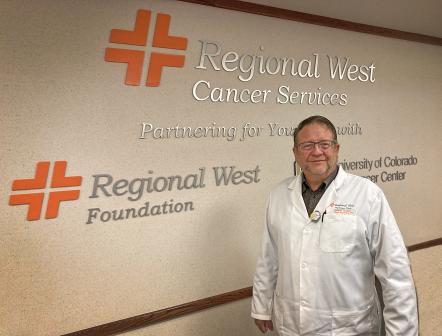
[Published Oct. 21, 2021] A new piece of technology is expected to bring enhanced cancer treatment with potentially fewer sessions for radiation therapy patients at the Cancer Treatment Center at Regional West.
All proceeds from the Regional West 2021 Gala will go toward a new Varian Edge™ linear accelerator to provide the technology to enter a new generation of radiation therapy treatments.
Regional West has had a linear accelerator, but advancements in technology have made newer machines even more effective, according to Mark Hartman, MD, a radiation oncologist with Regional West Physicians Clinic-Radiation Oncology.
“It would be faster as well as provide enhanced precision and accuracy,” Dr. Hartman said. “It’s going to be more convenient for patients because, in general, they will have fewer radiation treatments and spend less time in the cancer center and more time living life.”
In a radiation therapy department, a linear accelerator is a primary piece of equipment that produces radiation to be used for targeted therapy, primarily for cancer. Dr. Hartman said the machine can be used for treatment for a broad range of cancers, including cancers of the head and neck, lung, breast, esophagus, stomach, rectum, uterus, prostate, bladder, liver, bones, skin, and tumors in the brain and spine.
Keeping up with technology is critical in all types of healthcare, said Michael Yung, MD, with Radiology Imaging of Nebraska.
“Like anything in medicine, things evolve fairly quickly in treatment, and technology needs to keep up with the treatment,” Dr. Yung said. “As far as doing more targeted treatments, a new linear accelerator would allow us to provide advanced care to more patients.”
Treatment courses are more customized, and targeted to conform to the individual patient’s anatomy, as well as the location, size, and type of cancer that is being treated. By targeting these cancers with enhanced accuracy and precision, patient response to treatment can be maximized while minimizing radiation doses to normal surrounding tissues. Sparing the treatment of normal tissue reduces the side-effect risks associated with radiation therapy.
“It may allow me to offer radiation in a shorter course of treatment,” Dr. Hartman said. “That’s the name of the game for patients – less is more. It would often be a shorter course of radiation treatments.”
Being able to provide care to more patients means more patients being able to stay close to home for treatment.
“That’s a big deal for a lot of our patients,” said Regional West Physicians Clinic President Jeffrey Holloway, MD, FACS. “They’re our friends and our family members. We want to keep people here at home for their care whenever we can.”
Dr. Yung said cancer treatment can involve multiple treatments over multiple days or weeks, making it even more important to offer the treatments closer to home and not requiring patients to travel as often for their care.
“If patients have to travel to get therapy, they’re making multiple trips or staying out of town, and it can get very expensive,” he said. “The new linear accelerator could save patients time and travel and allow them to get their care locally. At times, it can be a long course of therapy, so providing a shorter course of treatment is a benefit for the patient.”